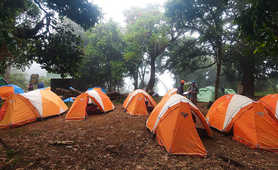
Kilimanjaro Montane Rainforest
Kilimanjaro has five distinct climate zones and after making your way to the national park gates through the cultivated lower slopes of the mountain, you'll experience is the dense tropical montane rainforest zone. It is hot and humid here and the cacophany of jungle sounds is astounding. Trek through lush green forest and catch glimpses of monkeys and birds flying through the canopy above.




























